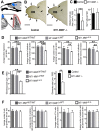Decreased demand for olfactory periglomerular cells impacts on neural precursor cell viability in the rostral migratory stream
- PMID: 27573347
- PMCID: PMC5004164
- DOI: 10.1038/srep32203
Decreased demand for olfactory periglomerular cells impacts on neural precursor cell viability in the rostral migratory stream
Abstract
The subventricular zone (SVZ) provides a constant supply of new neurons to the olfactory bulb (OB). Different studies have investigated the role of olfactory sensory input to neural precursor cell (NPC) turnover in the SVZ but it was not addressed if a reduced demand specifically for periglomerular neurons impacts on NPC-traits in the rostral migratory stream (RMS). We here report that membrane type-1 matrix metalloproteinase (MT1-MMP) deficient mice have reduced complexity of the nasal turbinates, decreased sensory innervation of the OB, reduced numbers of olfactory glomeruli and reduced OB-size without alterations in SVZ neurogenesis. Large parts of the RMS were fully preserved in MT1-MMP-deficient mice, but we detected an increase in cell death-levels and a decrease in SVZ-derived neuroblasts in the distal RMS, as compared to controls. BrdU-tracking experiments showed that homing of NPCs specifically to the glomerular layer was reduced in MT1-MMP-deficient mice in contrast to controls while numbers of tracked cells remained equal in other OB-layers throughout all experimental groups. Altogether, our data show the demand for olfactory interneurons in the glomerular layer modulates cell turnover in the RMS, but has no impact on subventricular neurogenesis.
Figures




References
Publication types
MeSH terms
Substances
LinkOut - more resources
Full Text Sources
Other Literature Sources
Molecular Biology Databases
Miscellaneous

